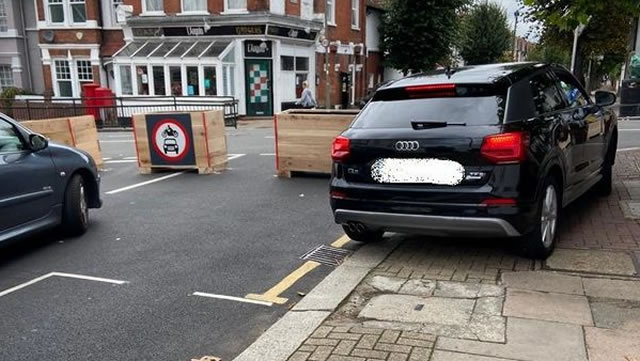Why Wandsworth Council Ditched Lower Traffic Neighbourhood Schemes
Concerns from emergency services, traffic issues and even vandalism were raised

Drivers mounting pavements to get through blocked off roads. Picture: One Wandsworth
Concerns from emergency services, traffic issues and even vandalism are just some of the reasons why Wandsworth Council decided to ditch its Lower Traffic Neighbourhood Schemes.
After only being introduced in August, using funding from TfL and the Department for Transport worth £350,000, all seven of the borough’s LTNs were suspended on September 11, with physical planters removed within days.
A report presented to the council’s Strategic Planning and Transport Overview and Scrutiny Committee (September 22), said “significant concerns had been raised by the NHS, the Metropolitan Police and the Fire Brigade related to extended response times as well access more generally to the hospitals within the LTN areas.”
It added that there were “serious and continuing traffic problems” around most of the LTN sites, with Tooting seeing estimated traffic journey times at least 25 per higher than before coronavirus.
The report also highlighted an “unprecedented” number of concerns and petitions, as well as anecdotal evidence from traffic engineers that cars had been driving on pavements and there had been cases of vandalism and damage.
Officers will still be monitoring the network around the suspended LTN areas and will continue to gather data.
This is particularly significant considering the new measures brought in by TfL as part of Cycle Superhighway 7, particularly along the A24 Balham High Road to Tooting High Street.
This has included moving bus stops, installing cycle lane segregation, banning turns at a number of junctions and removing parking.
Some residents believe these measures are also causing more traffic.
Lorna Blane from the campaign group One Wandsworth told the Local Democracy Reporting Service: “The LTNs pushed every vehicle on to the main road, but at the same time the Cycle Superhighway meant that what was three lanes of traffic became one lane.”
She said the ‘wands’ used to separate the cycle lane have made it difficult for cars to pull over for emergency vehicles, and that changes to bus stops mean people sometimes have to walk across the cycle lane to get to the pavement.
“It was literally a case that if you had to go out in a car you had to get a map out and try and work out how to get there and how to get home because there were so many ‘no lefts’, ‘no rights’, ‘can’t go here’, and ‘can’t go there.’
“It absolutely divided communities and split areas into two.”
However, many residents liked the LTN schemes and want to see more cycling provision, especially in Tooting and Balham which have seen a number of cyclists fatally injured in recent years.
The CS7 cycle route has seen 405 collisions in the 36 months to December 2019, according to a document produced by TfL.
Resident Ellie Pyemont presented a deputation to the council, explaining how her nearest LTN in South Graveney encouraged her and her family not to use the car for journeys within a 10km radius of home.
She said: “They weren’t perfect; they needed amending. People needed support, information and incentives not to drive so they could leave space for those who needed to. But then overnight they were gone, our kids were gutted. They had begun to see the streets about them in a different way.”
She said that losing the LTNs “has already made going car-free in Wandsworth much more of a battle.”
“Riding with the kids now is a constant trade-off between wanting to help them get more experienced and therefore safer, and being hyper-alert for all potential adverse driver behaviour, which happens frequently.”
She said the segregated cycle lanes on the A24 brought in by Tfl “means that getting out and about with kids on bikes remains an option” and “not feel like we are dicing with death.”
The committee voted unanimously to work with TfL on the A24 trial “to end road deaths and injuries on one of the most dangerous and polluted roads in Wandsworth.”
Residents are encouraged to provide feedback to TfL on the scheme at streetspacelondon@tfl.gov.uk.
Sian Bayley - Local Democracy Reporter
September 25, 2020
Related links
|
Council Says Lessons Learned in Early Days of LTNs Register for your newsletter from: |